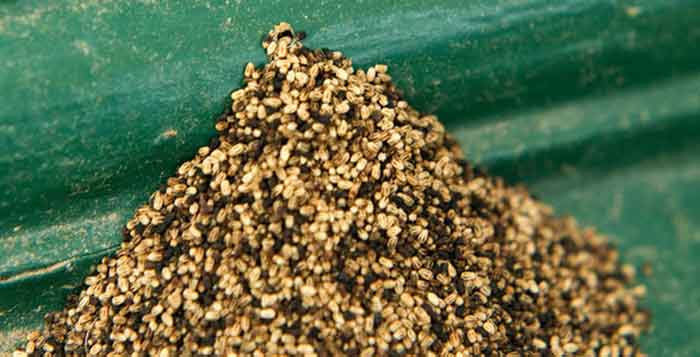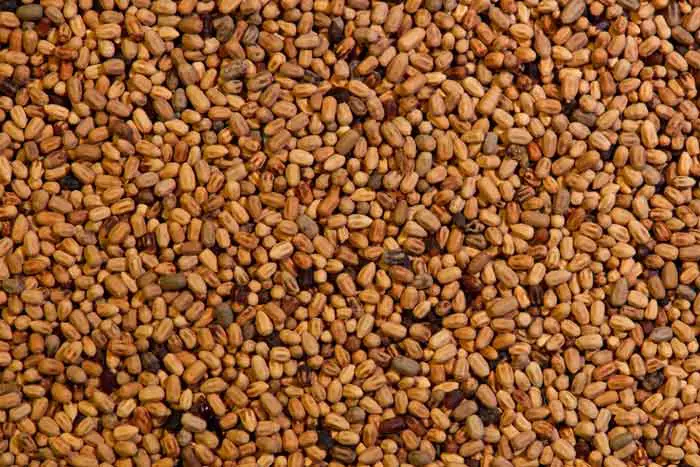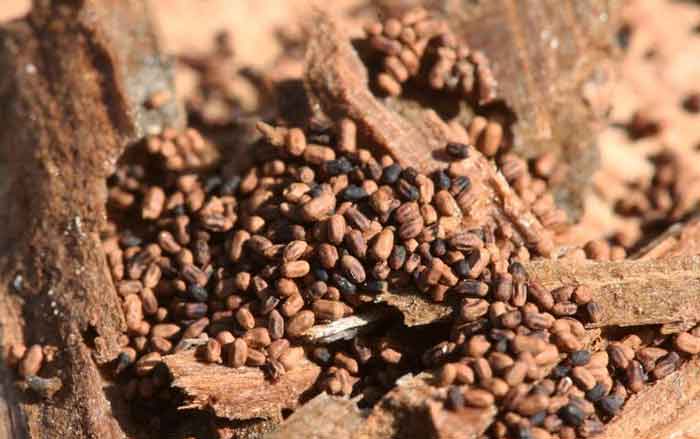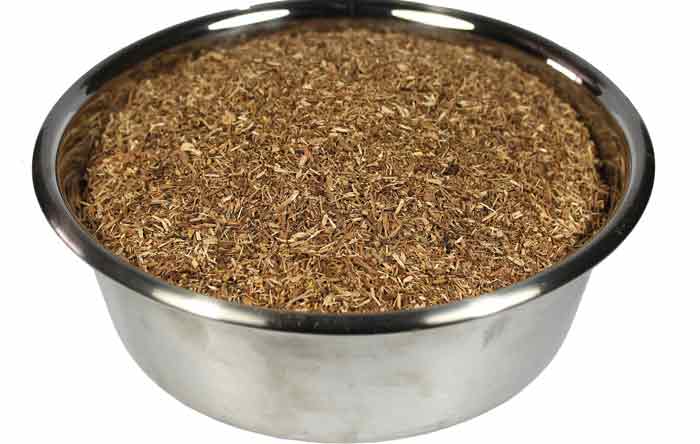The knowledge of how the poo of termites is crucial as one of the approaches you can undertake to keep your home safe from these destructive insects. They are in most cases confused with sawdust. In here, learn how the fecal matter looks like in pictures, health risks and how to clean up.
Table of Contents
Why are Termite Droppings in your place?
The excrement from the termites are mostly considered toxic but the truth is that they are not. This section will explain to you what thoughts should race in your mind the moment you spot them.
What do presence of termite Frass/pellets/fecal matter mean?
The process of detecting the presence of termites in your home can be an uphill task. However, the presence of the droppings can just be the best place to start from. This is one of the evidences termites can leave behind after colonizing an area.
The droppings show that there is an activity of some healthy termites within your surroundings. The termites that stay within the woods make holes so as to push the Frass in order to prevent the poop from getting to their nests.
The poop by the termites are also called Frass. The different types of termites can leave behind different types of droppings. For instance, the Formosan subterranean termites use their dropping to make tubes at the bottom of the building or the woods where they live.
Where can you find the droppings
The areas you can find the droppings are;
On your bedding
This is in most cases an indication that the termites have infested your roof. You should look for small holes that are not bigger than pin holes on the ceiling of your house.
Window sill
The droppings appear to be out of place. Together with the droppings, you can also find the wings. The termites can want to build their nests and tunnels using the Frass. They occupy the dry woods more as compared to the moisturized woods. This attributes greatly as to why they can comfortably colonize the window sills.
Carpets
Any material that has cellulose is culpable for termites’ colonization. They however can go overboard to attack non-cellulose materials like the carpets.
The termites work hard to look for food under the carpets and as a result, their efforts are in vain. The end result is formation of holes on the carpet and in the end you will see the piles of poop.
The floor
You can also see the poop being kicked out of the cracks of the walls of your house. As a result, the poop will land on the floor.
What do termite feces look like?
The species of the termite under consideration determines the appearance of the poo. Further, the type of wood or the cellulose the termite feeds on is a key determinant.
Subterranean termites release the largest amount of droppings. Their poop looks liquid when looked at. The liquid poop is useful for the termites to make mud tubes that enable them to squeeze through the cracks in order to look for food in your house.
The termites also use the droppings as cement to make bridges in the nests deep in the nests so as to easily access food.
For the drywood and dampwood termites, their droppings maybe recognized because they look like pellets. The pellets look like coffee grounds
In other occasions, they look like saw dust or even sand. Based on the type of wood or cellulose the termite feeds on, the color may look beige to dark brown. The pellets can also be black.
Drywood and dampwood termite poop look similar and they are hard having the shape of grains of rice about 1/25 of an inch long.
The ends are rounded and have a hexagonal configuration. The sides have depressions as a result of the pressure that is exerted on them by the gut of the termites when expelling them.
Pictures
The images below will help you have a clearer picture of the termite droppings.
The images portray all the types of poops from various termites and dependent on the different types of woods the termites feed on.
Termite Droppings health risks
Unlike the droppings from other animals, the droppings from the termites are not harmful to your health. They do not spread non-communicable diseases once you come into contact with them as it can be seen in the droppings from rats.
The unlikelihood of the health concerns can be proven by the fact that some people in Africa even eat the droppings on a daily basis. There are other cases where contact with the droppings can lead to allergic reactions. These reactions can get worse with time.
In other instances, the droppings make asthma attacks worse. Generally, the droppings do not have major health risks to raise antennae.
How clean up termite Frass
The moment you see the droppings in your house, carry further investigation to determine the presence of termites. Look around to see whether you can find the holes in which the termites hide the poo. The holes are never bigger than pin holes on the roof or the ceilings where you spot the droppings.
Once you have identified the holes, you can go ahead to clean the area under infestation. It is important to identify the holes because they help you notice where the insects reside.
The best way to handle the poo is always to device the methods that eliminate the termites. This is because in as much as you sweep away the poo, if the termites are present, then the poo will still accumulate. After using the right termite eradication method, replace your carpet or the infested surface.
You can use chemicals as well as home remedies to get rid of the termites from your home. You should take care because the chemicals can have some health risks. Listed below are some brief descriptions of the remedies you can use to eradicate the termites:
- Sunlight and frost: exposure of the termites to sunlight roasts and kills them. They love darkness.
- Subjecting the termites to extremely cold temperature is also an effective method because the termites cannot stand this.
- Boric acid: it is a chemical that is included in many insecticides. It is known to dehydrate the pest and this thus damages their nervous system.
- Cardboard trap: take two sheets of cardboard and then moisten them using warm water and put one over the other. Put this construction at the place you have noticed the termites. This is an efficient trap as you will notice a number of termites the next morning.[1]
Termite Droppings vs Sawdust
Termites’ droppings and saw dust look alike. If you see the saw dust and the termite droppings for the first time, you may not be able to bring out the difference.
The shape of the two is what makes them different.
At times the use of a magnifying lens can be the only way to bring out the difference between the two. Termite droppings appear granular and their colors vary.
Looking closely, you will notice that the termite droppings are 6-sided (hexagonal). On the other hand, saw dust look like shiny silvers and savings compared to the granular shape of the droppings.
Subterranean vs. Drywood Termite Droppings
Having had a look at the droppings from termites in a general way, here is a discussion to bring out the difference between the droppings by the subterranean vs, drywood. The droppings from the subterranean termites are made to look like tubes of mud.
This makes it hard to distinguish them from the nests. The poop when mixed with dirt, debris and saliva helps to make the nests. The tubes when constructed help the termites to move underground.
The drywood termites’ droppings are always channeled through holes for expulsion. They look like fine grains of sand. They use this droppings as protection because they seal the galleries using the droppings. The poop is also hard and shaped like the grains of rice.
They are less than 1/25 an inch long[2]. Their shape is hexagonal with some depressions on the side. The depression is a result of the pressure that the gut exerts on them as they are eliminated.
Unlike the droppings by subterranean termites, which are hard to find because of their similarity to the nests, the drywood termites droppings are hard to locate because the termites drop them in hidden areas of the house like the basements and the isolated corners.
Further Reading
- Termite Droppings-Drywood, what they look like, Health Risks, Clean vs Sawdust
- Formosan Termites Pictures, Signs Treatment & Damage
- How to Get Rid, Kill Termites + Treatment Cost
- What Causes & Attracts Termites?
- Do Termites Bite Humans? Pictures & Remedies
- Flying Ants vs Termites-Differences & Similarities
- Termite Inspection Cost, Procedure, how long it takes & Training
- Termite Colony-Queen, Soldier, Worker & King
- Drywood Termites Treatment Cost, Get rid & Damage
- Termite Bond Cost, Benefits
- Termite Baits, Stations & DIY Traps
- Dampwood termites Pictures, Damage & Treatment
- Termite Tenting & Fumigation- Cost, Preparation, Safety & Cleaning After
- Termite Barriers (Shields): Types, Cost, how they Work & Products
- Termites Damage, Pictures, Repair Cost, Ceiling, Floors, Wood & Fix
- Best Termite Sprays-Orange Oil (DIY), Boric Acid & Spectracide Reviews
- Termites Life Cycle & Span-Eggs, Larvae, Baby & Adults
- How to Prevent Termites-Tips to Protect your Home
- Signs of Termites Infestation-How do you know if have you them?
- What do Termites look like? Pictures, Size, Color & Look-alikes
- Termites: Where From, Habitat, Eat, Noise, Types +more!
- Subterranean Termites Swarmers Treatment Cost, Damages & Pictures
- Flying Termites with Wings (Swarmers) Pictures & How to get Rid
References
[1] http://termitewood.com/swarming-termites-how-to-get-rid-of-them.html#Home_remedies_to_get_rid_of_termites_swarmers
[2] http://manoa.hawaii.edu/ctahr/termite/public/events/handout_dry-vs-sub.pdf



